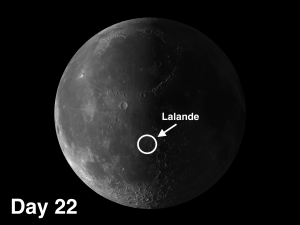The week of October 1-7 takes us from Day 22 to Day 28. This week we will highlight the crater Lalande A and its environs, visible after midnight on Monday.
 Lalande A: [SW/K9] As craters increase in size, their morphology progresses from simple through complex to basin. Simple craters are 10 miles in diameter or less; they start with rounded floors then progress to a flat floor resulting from a cascade of boulders that have rolled down the interior walls and settled at the bottom. Lalande A (only 8 mi. in diameter), located about 40 miles southwest of the crater Lalande, is a good example of a simple crater. With patience, good lighting, and decent optics you should be able to tell if Lalande A has a flat or rounded floor by looking at the shadow of the rim as it crosses the center of the floor. The rim shadow on a bowl-shaped floor will appear as a smooth arc. If the floor has partially filled with boulders, the shadow will be truncated (i.e., the apex will be squared off).
Lalande A: [SW/K9] As craters increase in size, their morphology progresses from simple through complex to basin. Simple craters are 10 miles in diameter or less; they start with rounded floors then progress to a flat floor resulting from a cascade of boulders that have rolled down the interior walls and settled at the bottom. Lalande A (only 8 mi. in diameter), located about 40 miles southwest of the crater Lalande, is a good example of a simple crater. With patience, good lighting, and decent optics you should be able to tell if Lalande A has a flat or rounded floor by looking at the shadow of the rim as it crosses the center of the floor. The rim shadow on a bowl-shaped floor will appear as a smooth arc. If the floor has partially filled with boulders, the shadow will be truncated (i.e., the apex will be squared off).
 The neighborhood around Lalande and Mösting (five crater-widths to the N.E.) offers up many simple craters for your examination. Spend some time searching for evidence that they are either flat-floored or rounded. (Check out nearby Mösting A, for example, on the west rim of the flooded crater Flammarion, and sweep the area all around Lalande.) For the next step, a crater in transition between simple and complex, pay a visit to Hell (Really!).
The neighborhood around Lalande and Mösting (five crater-widths to the N.E.) offers up many simple craters for your examination. Spend some time searching for evidence that they are either flat-floored or rounded. (Check out nearby Mösting A, for example, on the west rim of the flooded crater Flammarion, and sweep the area all around Lalande.) For the next step, a crater in transition between simple and complex, pay a visit to Hell (Really!).
Hell: [SW/N9] This crater (named after a Hungarian astronomer with an unfortunate last name) is an example of a transition crater. As the energy of an impact increases, craters go from smooth simple bowls to magnificent complex affairs with central mountain peaks, terraces, and ejecta blankets. Extensive slumping of the walls of Hell has left an untidy floor.
======================
It is highly recommended that you get a copy of Sky and Telescope’s Field Map of the Moon, the very finest Moon map available for use at the telescope. It is available for $10.95 at www.skyandtelescope.com and on Amazon. All features mentioned in this blog will be keyed to the grid on the Field Map and will look like this: Plato: [NW/D9]
Credits:
Courtesy of Gray Photography of Corpus Christi, Texas
Lunar photos: NASA / USGS / BMDO / LROC / ASU / DLR / LOLA / Moon Globe. Used by permission
- Trio of Moon Craters with Distinct Personalities - April 22, 2024
- Hippalus Rilles on the Moon - April 15, 2024
- Moon Crater Janssen: How New Moon Craters are Superimposed on Top of Older Craters - April 8, 2024